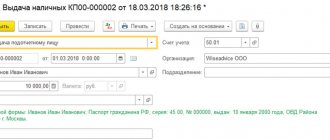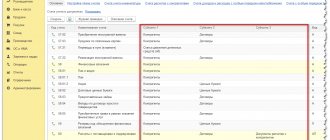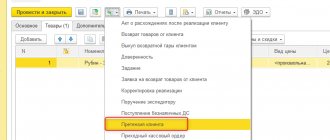Every accountant will tell you that one of the most difficult tasks in accounting is summing up the results of a period. But fortunately, 1C has a special mechanism that allows you to close a month without errors - no need to stress and worry that something went wrong. The main thing is to understand this mechanism and pay attention to the program prompts. So, let's figure out how to close the month in 1C 8.3 Accounting one, two, three!
For more details, see the online course: “Accounting and tax accounting in 1C: Accounting 8th ed. 3 from A to Z"
Which accounts are closed at the end of the year?
Before starting to prepare the annual financial statements, that is, before reforming the balance sheet, the accountant is required to generate the final entries for the reporting period. In accounting, the reporting period is a calendar month (clause 48 of PBU 4/99). Consequently, before closing the financial year, the accountant will need to draw up the final monthly turnover.
Which accounts are closed at the end of the month or year? Such BSCh can be tentatively divided into three groups:
- Cash balances that cannot have balances at the end of the reporting (financial) period. These include counting. 25 “General production expenses” and 26 “General operating expenses”.
- BSCs that may have a remainder, but which can be completely closed. These include counting. 20 “Main production”, 23 “Auxiliary production”, 29 “Service facilities and production”.
- BSCs that cannot have a general balance, but have a balance in open subaccounts. These are 90 “Sales” and 91 “Other income and expenses”.
Next, we will look at how accounts are closed at the end of the year; the entries are also suitable for generating final entries at the end of the month. We will determine the procedure for generating final accounting entries separately for each account, which directly affect the financial results of the company.
Closing the year in 1C: Accounting
Send this article to my email
In this article, we will consider the issue regarding the year-end closing operation in 1C: Accounting 3. At the end of the year, when all transactions are completed, the accountant should close the year. Based on this, it will be possible to judge how the organization performed and calculate financial indicators for the whole year. The last month of the year is the year-end closing. In this case, unlike closing the month, an additional procedure for reforming the balance sheet is carried out. What does this concept mean? It represents the December entry that determines the organization's net profit or loss. It comes after all other transactions are reflected in the accounting. This procedure is carried out using reg. operation, which is appropriately called “Balance Reformation”. It is also being processed “Month Closing” (section “Operations”)
Let's set up your 1C. We have been working since 2000. We are among the TOP 10 partners of 1C. Read more →
If, after opening in processing, you do not fill out the organization from the list, then the program will display the entire list of available operations.
Their number is determined by what we are closing - a month, a quarter or a year and by the completed documents for the period. On the processing form, all operations are located on four functional blocks from 1st to 4th, and are performed from block to block in ascending order. The operations of each subsequent one will be performed only if the operations from the previous one are completed correctly, which will be indicated to us by the mark next to the item. Before performing all actions, it is strongly recommended to download the information base.
Select the organization in the processing header and indicate the month. In our case, December. After this, we will see the following list of operations, which, among other things, will be determined according to the accounting policy.
It is possible to access the accounting policy parameters directly from the organization itself using the “Accounting Policy” hyperlink.
In addition, if a “marker” icon is displayed next to any item, this means that manual changes were made. Before closing, you must perform a reposting using the “Reposting documents” link. For example, users could change documents retroactively.
After completing the above steps, click “Perform month closure” and then the processing itself will sequentially perform all operations. The closure will be fully completed if each operation displays a green check mark and there are no errors. The status at the top will be updated to “Completed”.
By clicking the “References-Calculations” button, you can generate available reports from the list. To check the correctness at the end of the year, you can create a turnover balance sheet and make sure that accounts 90, 91 and 99 have a zero balance.
Also, to prevent the entry or correction of data in a year that is closed by us, it is recommended to set a date for prohibiting editing. Select the “Administration” section and then “User and rights settings”. Next, in the subsection “Dates of prohibition of changes” indicate the corresponding date. This can be done by a user with appropriate administrative rights.
Watch video instructions on channel 1C PROGRAMMER EXPERT
EVERYONE MUST DO THEIR JOB! TRUST THE 1C SETUP TO A PROFESSIONAL. MORE →
Discuss the article on the 1C forum?
We write off general production costs
The BSC is closed monthly, and all accumulated overhead costs must be written off to the accounts of the relevant production facilities. In other words, costs are written off to the accounts of those production facilities that were serviced.
Typical accounting entries:
| Operation | Debit | Credit |
| ODA written off in favor of core production | 20 | 25 |
| ODA included in the costs of servicing auxiliary production facilities and workshops | 23 | 25 |
| ODA aimed at maintaining service farms is written off to the appropriate accounts | 29 | 25 |
Write-off of general business expenses
The procedure for concluding an account. 26 depends on the method of forming the cost of finished products (sold services, work), which must be enshrined in the accounting policy of an economic entity. So, there are two key ways:
- At full production cost, the following standard transactions are generated monthly:
| Operation | Debit | Credit |
| OCR written off for main production | 20 | 26 |
| OCR included in the costs of auxiliary production | 23 | |
| OCR written off to service farms | 29 |
- According to the reduced production cost, all general operating costs are charged directly to the operating cost of sales. In this case, a monthly accounting entry is generated:
| Operation | Debit | Credit |
| OCR written off as the cost of products, works, services | 90-2 “Cost of sales” | 26 |
Closing production accounts
Let's make a reservation right away that the balance for BSC 20, 23, 29 is unfinished and does not require mandatory write-off at the end of the reporting or financial periods.
How to determine? If the production cycle does not coincide with the reporting periods, then a debit balance is formed on the BSC - the cost of work in progress. And if the production process fits into a calendar month (year), then, according to the BSC, there should be no leftovers. Typical entries for writing off production costs:
| Operation | Debit | Credit |
| Production costs written off to cost of sales | 90-2 “Cost of sales” | 20 |
| 23 | ||
| 29 |
Note that companies whose activities are related to the provision of services can additionally establish in their accounting policies which accounts are closed at the close of the month. In other words, to secure that BSCs 20, 23, 29 will be closed monthly, without any work in progress balances.
Block 2
This block is associated with the calculation of the share of write-off of indirect expenses. The fact is that, according to the Tax Code of the Russian Federation, some expenses may not be taken into account in full, but depending on a certain base. For example, sometimes advertising or entertainment expenses are subject to rationing, etc. In 1C, all such types of expenses are considered indirect. They should not be reflected on account 20; this may lead to errors in tax accounting. In our case, we show an option where advertising costs amounted to 5,000 rubles, but you can only accept a thousand. The calculation certificate will show this situation.
Fig.16 Block 2
We close accounting account 90 “Sales”
At the end of the reporting month, the company is obliged to determine the financial result of its activities. This operation is a comparison of subaccounts. 90. That is, the accountant compares the indicators of subaccount 90-1 “Revenue” and the value of cost of sales, which is defined as the sum of subaccounts 90-2 “Cost”, 90-3 “VAT”, 90-4 “Excise taxes”, 90-5 “Trade and export duties."
If the company made a profit (revenue exceeded total costs), then the accountant generates the following entry:
Dt 90-9 Kt 99 - profit from sales is reflected.
If the company operates at a loss (revenue is lower than total costs), then the following entry is recorded:
Dt 99 Kt 90-9 - reflects the monthly loss for the company’s activities.
Consequently, subaccounts. 90 may have a balance at the end of the reporting month, but the total value of the synthetic BSC must be equal to zero.
Which accounts are closed at the close of the year? The following accounting entries are generated for this account at the end of the year:
| Operation | Debit | Credit |
| The “Revenue” sub-account was closed at the end of the year | 90-1 | 90-9 |
| The cost of production is included in the financial result | 90-9 | 90-2 |
| VAT is written off in favor of profits and losses | 90-9 | 90-3 |
| Excise taxes are included in the financial results of operations | 90-9 | 90-4 |
| Export trade duties written off at the end of the year | 90-9 | 90-5 |
Basic accounting entries for year-end closing
Sales analysis
To summarize the results of activities of organizations for ordinary activities, it is necessary to analyze the subaccounts of account 90:
- 90.1: this subaccount displays all receipts received by the company for goods sold. The balance of the subaccount is the revenue received for the period:
Dt50.51 Kt90.01 – payment received;Dt62 Kt90.01 – sales revenue is reflected;
- 90.02: cost of goods sold upon sale:
Dt90.02 Kt41 – write-off of the accounting value of goods;Dt90.02 Kt20 – cost of work performed;
- 90.03: VAT accrued for payment to regulatory authorities is displayed:
Every month, the subaccount data is compared, and the balance is transferred to subaccount 90.09, which displays the calculated financial results: Dt - loss; Kt – profit.
When closing the period, the balances of 90.09 go to the debit of account 99 with the profit received for ordinary types of business activities and to the credit of the account. 99 for unprofitable work.
Analysis of non-operating activities
For transactions not related to the normal business activities of the organization, the analysis is carried out on the basis of monitoring subaccounts of 91 accounts:
- 91.01: the subaccount is intended to contain information about other income of the company. These may include: exchange rate differences, surplus inventories as a result of inventory, income from borrowed funds provided to counterparties, etc.:
Dt50.51 Kt91.01 – income received from the sale of own equipment;Dt73 Kt91.01 – income from loans provided in the form of interest paid;
- 91.02: information about all non-operating costs is collected here: bank commissions, shortages of goods, tax fines and penalties, etc.:
Dt91.02 Kt66.67 – payment of interest for the use of borrowed funds;Dt91.02 Kt01 – reduction in the cost of equipment based on the results of revaluation.
Every month, the subaccount data is compared, and the balance is transferred to subaccount 91.09, which displays the calculated financial results: Dt - loss; Kt – profit.
When closing the period, the balances of 90.09 go to the credit of account 99 for profit received for ordinary types of business activities and to the debit of the account. 99 for unprofitable work.
Balance Reformation
After closing all main accounts in accordance with the accounting rules and analyzing all collected information, the balance sheet is reformed - identifying the overall financial result and assigning it to the account.
We close account 91 “Other income and expenses”
The company must determine monthly financial results based on income and expenses from other activities. This financial result is determined as the difference between the subaccounts of the account. 91. That is, we compare 91-1 “Other income” with 91-2 “Other expenses”.
The results of activities are reflected in the following accounting entries:
| Operation | Debit | Credit |
| Profit at the end of the month from other types of company activities is reflected | 91-9 | 99 |
| Reflected loss from other activities | 99 | 91-9 |
At the end of the financial year, the accountant makes the following entries:
| Operation | Debit | Credit |
| Profit for the year from other types of company activities was written off | 91-1 | 91-9 |
| Reflected loss from other activities for the year | 91-9 | 91-2 |
In turn, count. 99 “Profit and Loss” remains unclosed. This BSCH closes on December 31st. The accountant generates the following entries:
- Dt 99 Kt 84—– reflects the net profit of the reporting year;
- Dt 84 Kt 99 - the company's uncovered loss is reflected.
How can an accountant close the year?
At the end of the year, review all account balances. To do this, conduct an inventory of property and settlements with suppliers and customers. After that, do a balance reformation. How to take inventory of property
Before starting an inventory, draw up an order for its implementation. A special form No. INV-22 is provided for it.
| Documents for registration of inventory are in the Decree of the State Statistics Committee of August 18, 1998 No. 88 |
How to fill out this order is written in the “Primary Documents”
on page II/04/03. The company's property is fixed assets, intangible assets, materials, money, etc. To carry out their inventory, you need to: - draw up an inventory list or an inventory act; - draw up a matching statement; — fill out a statement based on the inventory results; - reflect the inventory results in accounting. Please note: an inventory of fixed assets can be carried out once every three years.
How to draw up an inventory list (act)
Special forms are provided for inventory records and acts. Draw up an inventory report for future expenses (form No. INV-11) and shipped goods (form No. INV-4). In addition, draw up a report when checking money at the cash register. A special form No. INV-15 is provided for this document. When checking other property, make an inventory list. Complete a separate inventory for each type of property. Write out this document for fixed assets (Form No. INV-1), for materials (Form No. INV-3), etc. Complete these documents in two copies. Leave the first one in the accounting department, and give the second one to the employee responsible for the safety of property. This person must sign on the first page of each inventory. By this, he confirms that the property has been accounted for (accounted for or written off) according to all primary documents. This must be done before the inventory begins. As you take inventory, check your possessions. To do this, count fixed assets, weigh raw materials, etc. As you do this, fill out inventory records and acts. After the inspection is completed, all inventories must be signed by members of the inventory commission.
How to make a matching statement
If you find that some property is missing, or find items that are not included in the accounting records, then draw up a matching statement. There are two forms for matching statements: No. INV-18 and INV-19. Draw up the first after checking fixed assets, the second - after taking inventory of goods, materials, etc. Please note: the matching statement does not need to be drawn up after checking the money at the company's cash desk. Reflect the surplus or deficiency immediately in the inventory report. Prepare the matching statement in two copies. Leave the first one in the accounting department, give the second one to the employee responsible for the safety of valuables.
How to fill out a statement based on inventory results
| Form No. INV-26 is in the Decree of the State Statistics Committee of March 27, 2000 No. 26 |
For the statement of accounting for inventory results, there is a special form No. INV-26. It will reflect the final data for all types of property. Take the data for filling out this document from inventory lists and matching statements.
How to reflect inventory results
If you find property that is not registered, then capitalize it with the following posting: Debit 10, 41... Credit 91-1
— the property identified during the inventory has been capitalized.
If you find that any property is missing, then make the following entry for its value: Debit 94 Credit 10, 41...
- the shortage of property is reflected.
For some property (for example, sugar, fruit), norms of natural loss have been established. Reflect the shortfall within these standards as follows: Debit 20, 44 Credit 94
— the shortage is reflected within the limits of natural loss norms.
If the norms of natural loss have not been established for the property or the amount of the shortage is greater, then determine the guilty parties. As a rule, this is the person responsible for the safety of goods, materials, etc. In this case, write off the shortage as follows: Debit 73-2 Credit 94
- the shortage is written off at the expense of the guilty person.
If the culprit could not be found, then write off the shortage as follows: Debit 91-2 Credit 94
- a shortage has been written off for which the culprit has not been identified.
Example 1.
On December 28, 2002, Passiv LLC carried out an inventory of the warehouse.
As a result, spare parts worth 10,000 rubles were found that were not included in the accounting records. In addition, the inventory commission revealed a shortage of two wheels. They cost 6,000 rubles. The cost of the wheels is written off at the expense of the warehouse manager. The Liability accountant reflected these transactions as follows: Debit 10 Credit 91-1 - 10,000 rubles.
— spare parts have been capitalized; Debit 94 Credit 10
- 6000 rub.
— the shortage of wheels is reflected; Debit 73-2 Credit 94
- 6000 rub. — the shortage was written off at the expense of the warehouse manager.
How to take inventory of payments
To carry out an inventory of settlements with suppliers and buyers, you need to: - draw up a statement of reconciliation of settlements; — draw up an inventory report; - reflect the inventory results in accounting.
How to draw up a reconciliation report
There is no special form provided for the reconciliation report. Therefore, compose it in any form. For example, it might look like this:
Statement of reconciliation of settlements between Passiv LLC and Aktiv CJSC as of December 31, 2002
dated December 31, 2002
| Incurrence of debt of CJSC Aktiv to LLC Passive | Repayment of debt of ZAO Aktiv to LLC Passiv | ||||
| date | Sum | Base | date | Sum | Base |
| 28.10.2002 | 600,000 rub. | Invoice No. 86 | 18.11.2002 | 800,000 rub. | Payment order No. 698 |
| 20.11.2002 | 650,000 rub. | Invoice No. 94 | — | — | — |
| Total | RUB 1,250,000 | — | — | 800,000 rub. | — |
The total debt of ZAO Aktiv to LLC Passiv as of December 31, 2002 is 450,000 rubles.
| Director of JSC "Aktiv" | Director of Passiv LLC |
| /Ivanov A.G./ | /Sidorov R.G./ |
Execute this act for each buyer and supplier in two copies. Leave the first copy in the accounting department, send the second to the company with which the reconciliation was made.
How to draw up an inventory report
For the act of inventory of settlements with debtors and creditors, there is a special form No. INV-17. How to fill out this document is written in the “Primary Documents”
on page IX/02/06.
How to reflect inventory results
Based on the inventory results, identify debts for which the statute of limitations has expired. Write them off as other income (if you owe) or other expenses (if the debt is owed to you).
| The statute of limitations is three years |
To write off the debt, the manager must draw up an order. How to draw up an order to write off a buyer’s debt and reflect this operation in accounting is written in the June issue of our magazine. Draw up an order to write off your debt in any form. For example, it might look like this:
CJSC "Aktiv"
Order
| dated December 31, 2002 | № 3112/2202 |
On writing off overdue accounts payable
Based on the Inventory Act of settlements with buyers and suppliers dated December 31, 2002, I order to write off the expired debt to Delta LLC in the amount of 12,000 rubles.
General Director of Aktiv CJSC /Ivanov A.G./
Write off your debt with the following entry: Debit 60, 76 Credit 91-1
— debt with an expired statute of limitations is written off.
How to reflect the balance sheet reformation
After you have checked the balances of all accounts, reform the balance. Reflect it in accounting on December 31, 2002. Balance sheet reformation is the closing of the following accounts at the end of the year: - 90 “Sales”; — 91 “Other income and expenses”; — 99 “Profits and losses.” The balance of subaccounts of these accounts as of January 1, 2003 should be equal to zero.
How to close accounts 90 “Sales” and 91 “Other income and expenses”
You reflected the data on the subaccounts of these accounts on an accrual basis from the beginning of 2002. As a result, there are balances on them as of December 31st. Write them off to subaccounts 90-9 “Profit/loss from sales” and 91-9 “Balance of other income and expenses.” An example will tell you how to do this.
Example 2.
As of December 31, 2002, the accounts of Aktiv CJSC include the balances of the following subaccounts: - for loan 90-1 “Revenue” - 600,000 rubles;
— by debit 90-2 “Cost of sales” — 300,000 rubles; - according to debit 90-3 “VAT” - 100,000 rubles; - for loan 91-1 “Other income” - 50,000 rubles; - according to debit 91-2 “Other expenses” - 120,000 rubles. The Aktiva accountant reflected the reformation of accounts 90 and 91 as follows: Debit 90-1 Credit 90-9 - 600,000 rubles.
— subaccount 90-1 was closed at the end of the year; Debit 90-9 Credit 90-2
- 300,000 rubles.
— subaccount 90-2 was closed at the end of the year; Debit 90-9 Credit 90-3
- 100,000 rubles.
— subaccount 90-3 was closed at the end of the year; Debit 91-1 Credit 91-9
- 50,000 rubles.
— subaccount 91-1 was closed at the end of the year; Debit 91-9 Credit 91-2
- 120,000 rubles. — subaccount 91-2 was closed at the end of the year.
How to close account 99 “Profits and losses”
| How to close account 99 “Profits and losses”, it is written in the “Correspondence of accounts” berator on page VIII/99/09 |
After the end of the year, accrue income tax: Debit 99 Credit 68 subaccount “Calculations for income tax”
- income tax is accrued at the end of the year.
After this, a credit or debit balance may appear on account 99 “Profit and Loss”. In the first case, the company made a profit at the end of the year, in the second - a loss. Reflect the profit as follows: Debit 99 Credit 84
- reflects the net profit of the company at the end of the year.
Write off the loss as follows: Debit 84 Credit 99
- reflects the loss at the end of the year.
Example 3.
Let's use the data from example 2. Based on the results of 2002, the income tax of “Asset” is equal to 40,000 rubles.
The company's net profit at the end of 2002 will be equal to: 600,000 rubles. — 100,000 rub. — 300,000 rub. + 50,000 rub. — 120,000 rub. — 40,000 rub. = 90,000 rub. The accountant “Asset” closed account 99 “Profits and losses” as follows:
Debit 99 Credit 68 subaccount “Calculations for income tax”
- 40,000 rubles.
— income tax is charged; Debit 99 Credit 84
- 90,000 rub. — net profit for 2002 is reflected.
S. SHIKIN Material provided by the magazine “ Practical Accounting”
PRACTICAL ENCYCLOPEDIA OF AN ACCOUNTANT
Complete information about accounting rules and taxes for an accountant. Only a specific algorithm of actions, practical examples and expert advice. Nothing extra. Always up-to-date information.
Connect berator








